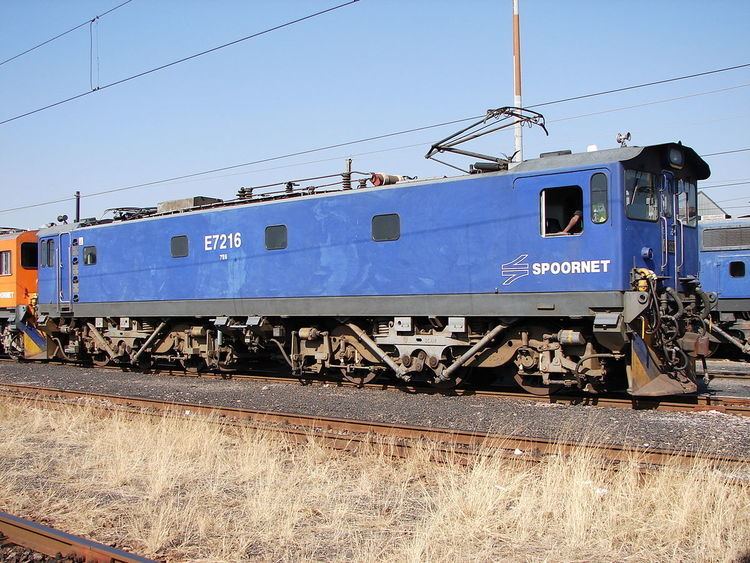Power type Electric Builder Dorbyl Build date 1983-1984 | Total produced 60 | |
 | ||
The South African Railways Class 7E3, Series 1 of 1983 is an electric locomotive.
Contents
- Manufacturer
- Appearance
- Pantographs
- Brakes
- Bogies
- Class 7E4
- Class 7E5
- Class 7E6
- Revert to Class 7E3
- Service
- Illustration
- References
Between 1983 and 1984, the South African Railways placed sixty Class 7E3, Series 1 electric locomotives with a Co-Co wheel arrangement in mainline service. Beginning in 2001, sixteen of these dual cab locomotives were rebuilt to single cab locomotives and reclassified to Class 7E4.
Manufacturer
The 25 kV AC Class 7E3, Series 1 electric locomotive was designed for the South African Railways (SAR) by Hitachi and built in South Africa by Dorbyl, who also supplied the mechanical components. Sixty locomotives were delivered by Dorbyl between 1983 and 1984, numbered in the range from E7216 to E7275.
Like Union Carriage and Wagon (UCW), Dorbyl did not allocate builder’s numbers to the locomotives it built for the SAR, but used the SAR unit numbers for their record keeping.
Appearance
These dual cab locomotives have a roof access ladder on one side only, just to the right of the cab access door. The roof access ladder end is designated the no. 1 end. Series 1 and Series 2 locomotives are visually indistinguishable from each other, but the two sides of both series are sufficiently different in appearance that a pair of them, coupled at the same ends, appears at first glance to be two different locomotive types. The roof access ladder side is smooth, while the other side has several large grilles.
Pantographs
The locomotive's pantograph placement is unusual, in not being equidistant from the locomotive ends. The contact shoe centre of the no. 1 end pantograph is 6,155 millimetres (20 feet 2.3 inches) from the longitudinal centre of the locomotive, while that of the no. 2 end pantograph is 5,920 millimetres (19 feet 5.1 inches) from the longitudinal centre.
Brakes
On the Class 7E3, Series 1, control of traction and rheostatic braking is by stepless solid-state electronics. The electrical equipment was designed for high power factor operation, obtained by the switching in of power-factor correction capacitors.
Unlike the Classes 7E and 7E2 Series 1 and 2, where thyristors are used, these locomotives feature silicon-diode rectifiers.
Bogies
To reduce flange and rail wear, the bogies of the Class 7E3 have a shorter wheelbase than the Class 7E1, 4,060 millimetres (13 feet 3.8 inches) instead of 4,400 millimetres (14 ft 5.2 in).
Like the Class 7E1, the Class 7E3 was built with sophisticated traction linkages on the bogies. Together with the locomotive's electronic wheel-slip detection system, these traction struts, mounted between the linkages on the bogies and the locomotive body and colloquially referred to as grasshopper legs, ensure the maximum transfer of power to the rails without causing wheel-slip, by reducing the adhesion of the leading bogie and increasing that of the trailing bogie by as much as 15% upon starting.
Class 7E4
In the period from the early 1990s until 2007, various modifications to improve downhill braking capacity were done to the Coalink line’s Hitachi-designed locomotives. The first set of upgrades were done on the fifty Class 7E1 locomotives.
From 2001, seventeen Class 7E3 locomotives, sixteen Series 1, numbers E7260 to E7275, and one Series 2, no. E7276, underwent significant modifications. This included the installation of Hitachi micro-processor controls with improved rheostatic brakes, auxiliary inverters designed and built by Fuji, and the conversion from double cab to single cab, since the no. 2 end cab space was required for some of the new equipment which was installed. These modified single-cab locomotives were reclassified to Class 7E4.
Class 7E5
The conversions to Class 7E4 were costly, however, and it was decided to modify further Class 7E3 locomotives to a lesser extent, gaining almost the same benefits at a lower cost, since they remained as double cab locomotives. In total about fifty locomotives of both series were upgraded in this manner. These were reclassified to Class 7E5, although externally they were still identical to the Class 7E3.
Class 7E6
Following some systems failures on the upgraded Class 7E5 locomotives, a further variation in the modifications was applied to the remaining Class 7E3 locomotives which had not yet been upgraded. These locomotives were then reclassified to Class 7E6. Eventually all the Class 7E5 locomotives were also modified once again to meet the Class 7E6 specifications.
Revert to Class 7E3
By October 2007 all these locomotives were fully upgraded and standardised in respect of their rheostat flat topping and EPROM software. Since, apart from the single cab Class 7E4 conversions, they were once again all identical, those which had been reclassified to Classes 7E5 and 7E6 reverted to their original Class 7E3 classifications. Although numbers E7216 to E7259 are all officially designated Class 7E3, Series 1 once again, many of these forty-four locomotives still bore markings for several years to identify them as either Class 7E5 or Class 7E6. The single cab locomotives, however, remained classified as Class 7E4.
Service
Since 1978, 25 kV AC was introduced on all new mainline electrification projects bar one, the exception being the Orex iron ore line from Sishen to Saldanha, where 50 kV AC is used. The Class 7E3, Series 1 locomotives all served on the 25 kV AC Coalink line from Ermelo via Vryheid to the Richards Bay Coal Terminal, until sufficient numbers of the new Class 19E were available by about 2011 to allow some to be re-allocated to Pyramid South, north of Pretoria.
Illustration
The main picture shows no. E7216 in Spoornet blue livery with solid numbers, still inscribed "7E6". The difference between the sides of the locomotive and some other liveries which were applied to the Class 7E3, Series 1, are illustrated below.
